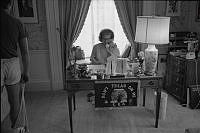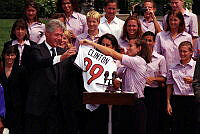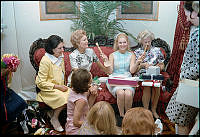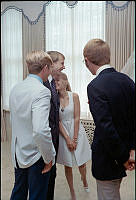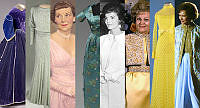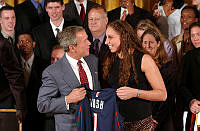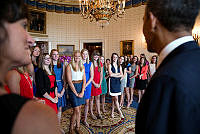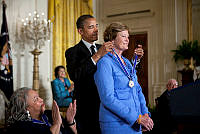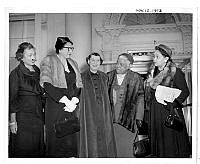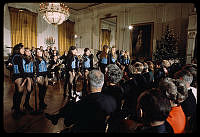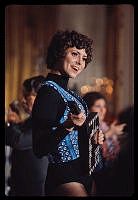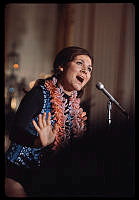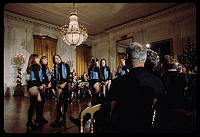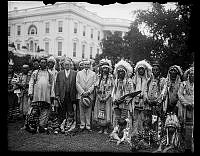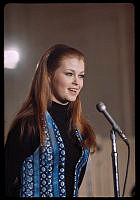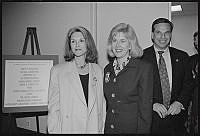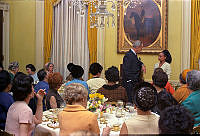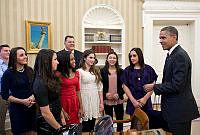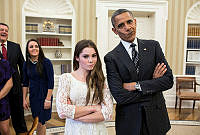Rubenstein Center Scholarship
Frances Perkins
Breaking Glass Ceilings in the Cabinet
The Secretary of Labor “quite blew our poor Undersecretary off his end of the phone.” -Diary of Jay Pierrepont Moffat, Chief of the Western European Division, U.S. Department of State1
Many Americans have never heard of Frances Perkins, and some only know her because of her historic appointment as the first woman cabinet secretary. However, she was also the longest-serving labor secretary in American history, a key architect of the New Deal, and an advocate for immigrants at the helm of the Immigration Naturalization Service (INS) when it was in her department.

Frances Perkins, c. 1935-1936. Courtesy Mount Holyoke College Archives and Special Collections
Mount Holyoke College Archives and Special CollectionsBorn in 1880, Frances Perkins was raised in a conservative and traditional Massachusetts family with ancestry tracing back to colonial New England. As a student in the Mount Holyoke College class of 1902, Perkins learned through field trips to the mills of Holyoke that unseen forces kept many working people in poverty. She immersed herself in communities of people in need as a volunteer at Jane Addams’s Hull House in Chicago from 1904 to 1907. In 1911, while living in New York City, thirty-year-old Frances Perkins witnessed the Triangle Shirtwaist Factory fire from directly across the street. The tragedy motivated her to join the New York State Factory Investigating Commission as chief investigator, a position that pointed her in the direction of a career that would transform American labor history.2
Perkins later ascended to the New York State Industrial Commission under Governor Al Smith, followed by her appointment as industrial commissioner, essentially a statewide labor secretary under Governor Franklin D. Roosevelt. She spearheaded economic recovery efforts across the state from 1929 to 1933, when Roosevelt became president. While she was not a rank-and-file union leader like previous labor secretaries, Perkins made sense as Roosevelt’s choice for secretary of labor, regardless of her sex. Since the 19th Amendment allowed women to vote in 1920, women’s groups had been campaigning for a woman cabinet secretary.
It would not be an easy job. From 1930 to 1933, five thousand banks had failed across the country, and by March 2, 1933, governors in twenty-one states had closed or limited withdrawals.3 On Saturday, March 4, following an Inauguration parade, the new Cabinet officers entered the front door of the White House. Perkins’s Inauguration ticket mistakenly specified the East Gate, but she found her way to the front door. Amid a backdrop of a national banking emergency, Roosevelt’s new cabinet appointees were sworn into their positions on the Second Floor of the White House in the Yellow Oval Room – a space that would become President Roosevelt’s private study.4 They were the first to be sworn in all on the same day in the White House and the first to include a woman among their ranks.

Roosevelt’s Cabinet, 1933. Courtesy Franklin D. Roosevelt Presidential Library and Museum
Franklin D. Roosevelt Presidential Library and MuseumFighting the lingering effects of the Great Depression was far from the only challenge that Perkins faced. She had to navigate the politics and power dynamics of being the only woman at the table and setting precedents in an important role. The first unofficial meeting of Roosevelt’s cabinet took place after church on Sunday, March 5, and the first formal one followed on the afternoon of Tuesday, March 7, in the Cabinet Room beside the Oval Office overlooking the Rose Garden. “I was apprehensive and on guard at the first official cabinet meeting,” Perkins later recalled in her 1946 memoir The Roosevelt I Knew, “As the only woman member, I did not want my colleagues to get the impression that I was too talkative. I resolved not to speak unless asked to do so.” She had a lot to say, however, and fortunately the president asked, “Frances, don’t you want to say something?”5
Perkins shared ideas to curtail unemployment, drawing from her extensive experience in New York. Amid many reasons for the national banking crisis, a key factor was high unemployment, causing people to withdraw their savings from banks. President Roosevelt decided to close all banks temporarily to reopen under new federal regulations. While these regulations addressed the urgent problem, Perkins aimed for long-term economic stability. Her public works ideas would later contribute to the Civilian Conservation Corps and the Works Progress Administration, creating millions of jobs for Americans to carry out tasks that would benefit the government and the society.
Perkins wanted to use Labor Department resources to combat unemployment and bank failures, but first she needed to address the reality that her predecessor under President Herbert Hoover, William Doak, devoted considerable resources to rounding up immigrant groups. The infamous Section 24, which took its name from an immigration provision that banned non-citizens from contract work in the U.S., acted as a federally employed mob that took pride in raiding immigrant communities and tricking them into grounds for deportation. Entering the labor department later that day on March 7, the outgoing Labor Secretary Doak had not even cleared out his office. Only two bureau heads – the only two women, it’s worth nothing – Grace Abbott of the Children’s Bureau, and Mary Anderson of the Women’s Bureau, had sent her congratulatory messages. Several different men introduced themselves to Perkins as in charge of immigration.6 Perkins let Section 24’s funding run out, and she requested an executive order to combine the Immigration and Naturalization Bureaus to create the Immigration Naturalization Service (INS). This way immigration resources could go toward what she and Commissioner of Immigration Daniel MacCormack considered a more humane approach.7
As secretary of labor, she could not make laws – that was Congress’s job – but she could steer their implementation creatively. For example, she leveraged a legal victory in a turf war with the Department of State to invent the corporate affidavit, which she used through a partnership with activists from the German-Jewish Children’s Aid, Inc. (GJCA) to coordinate a robust child refugee program starting in 1934. The corporate affidavit enabled an organization to raise funds to support an immigrant and to continue to vouch for them. The GJCA collected donations and kept track of child refugees through a partnership with the Children’s Bureau in Perkins’s Labor Department. This program continued throughout the German-Jewish refugee crisis, even as efforts in Congress failed to add immigration slots for child refugees. Enabling humanitarian organizations to support refugees epitomized Perkins’s value on collective and structural change to support individuals in need.8
Changing up policies and routines from the previous administration also enabled Perkins’s Department of Labor to help orchestrate the New Deal. Perkins was an essential political player in the Social Security Act of 1935, the National Labor Relations Act of 1935, and the Fair Labor Standards Act of 1938. These laws created social security, legalized unions and striking, and established the minimum wage and other worker protections, respectively. The National Labor Relations Act has also been called the Wagner Act after its lead sponsor, Senator Robert Wagner of New York, whose personal secretary quipped: “I don’t think President Roosevelt had the remotest interest in a Social Security bill or program. He was simply pacifying Frances.”9 The labor secretary entered cabinet meetings in short heels, a purse in hand, equipped with overwhelming evidence and research to support her claims.

Frances Perkins stands with President Roosevelt as he signs the Social Security Act in 1935.
Library of CongressHer successes, as well as vulnerability as the first woman to serve in such a prominent cabinet role, caused opponents of the New Deal to target Perkins. Hate mail rolled in from across the country. Some of her adversaries even suggested that Perkins, a practicing Episcopalian, was secretly Jewish.10 Bigots went out of their way to concoct this conspiracy theory because antisemitism, which was prevalent in American society, was another available tool to leverage. These opinions fit into a wide dialogue of antisemitic rhetoric, which somehow branded Jewishness as both capitalist and communist. As such, the anti-New Dealers often employed antisemitic tropes to oppose the New Deal’s restrictions on capitalism.
In early 1939, Perkins sat through a resolution to impeach her. The resolution accused her of plotting to overthrow the government. She was not convicted because there were no grounds for this accusation. Rather, opponents latched onto a strike led by Australian immigrant labor organizer Harry Bridges in California in 1934. Representing backlash against the National Labor Relations Act of 1935, which legalized unionizing, anti-New Dealers in Congress targeted Perkins for not deporting Bridges. While there were no grounds for deportation, congressmen pointed out that previous labor secretaries would have anyway. The impeachment hearing diminished Perkins’s political capital for the rest of Roosevelt’s presidency.11
“I have done what I could in time to make this great country of ours nearer our conception of the City of God,” Perkins told her adversaries in Congress. “I have consistently favored not only enforcement of law, but also a firm adherence to the basic American standards of fair play.”12 She was both correct and right.
In her memoir, Perkins credited her many accomplishments to President Roosevelt, even going so far as to attribute her ideas as his. In her experience, public attention meant danger and distress. Throughout her career, Perkins went above and beyond to work behind the scenes. Her most candid form of communication was speaking on the telephone. A detail-oriented workhorse, she kept her cards close to her chest. At the same time, however, her handbag and heels stood out under the table.13 Her appointment was meaningful to the broader progressive movement of predominantly women social reformers who shaped her.

Perkins family homestead in Newcastle, ME. Courtesy Frances Perkins Center
Frances Perkins CenterIn 1965, Frances Perkins was laid to rest beneath a modest headstone in Newcastle, Maine. Down the road is the Frances Perkins Center, a bustling historic site and hub for education, programming, and public service. With more women ascending to high political office in the U.S., the first woman cabinet secretary’s name and tenure take on increasing significance. As secretary of labor, setting precedent as the first woman gave her more to carry. As a historical figure, the extra burden that she took on only enhances her legacy.
About the Author
Rebecca Brenner Graham served as a 2023-2024 Research Fellow in the David M. Rubenstein National Center for White House History. She is the author of Dear Miss Perkins: A Story of Frances Perkins’s Efforts to Aid Refugees from Nazi Germany (Kensington, 01/21/2025). Rebecca is a postdoctoral research associate at Brown University. Previously, she taught at the Madeira School and American University. She has a PhD in history and MA in public history from American University and a BA in history and philosophy from Mount Holyoke College. In 2023, she was awarded a Cokie Roberts Fellowship from the National Archives Foundation and a Rubenstein Center Research Fellowship from the White House Historical Association. Her writing has been published in the Washington Post, Time, Slate, the Los Angeles Review of Books, and elsewhere.














